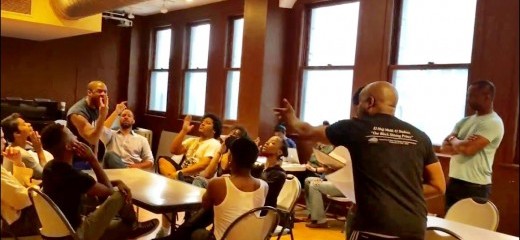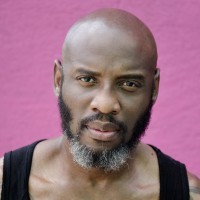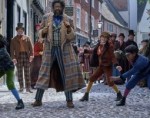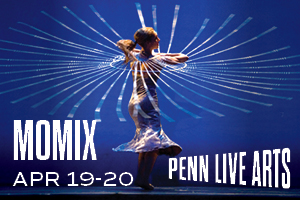
Classical Theatre of Harlem and Elisa Monte Dance: Creating Spaces and Collaborations in Macbeth
by Gregory King
In her 2014 closing plenary for Collegium for African Diaspora Dance Conference at Duke University, dance scholar Dr. Kariamu Welsh admitted she became a scholar out of necessity, explaining that she realized that the stories she wanted to tell were not being told. Welsh’s speech reminded me of a history that has forced minorities to create spaces for themselves, where they didn’t have to exist apologetically and their art could thrive. Dance Theatre of Harlem (DTH) was one result of that need, so was the Classical Theatre of Harlem (CTH). These institutions were set up as counter-narrative to skeptics who continue to nurture the belief that the black body is less suited for classicism.
Created to dispel that myth, CTH tackled Macbeth with a contemporary twist. Instead of the traditional story, CTH’s Macbeth was informed by Ethiopia during the time of Emperor Haile Selassie. This artistic gateway only widened, as CTH entered a unique collaboration with Elisa Monte Dance Company, whose newly appointed artistic director Tiffany Rea-Fisher also served as choreographer.
In a conversation with Carl Cofield, producing artistic director of CTH, Ty Jones who played Macbeth, and Jason Dulane Lee who played Macduff, we talked culture and collaboration.[i]
Gregory King: Do you believe that in 2016 there is still a need for minorities to create spaces for themselves?
Ty Jones: In every aspect of life, whether business, art, or the personal, standards were set. Historically, black people were forced to believe they never met those standards, so we had to create our own spaces. I am one hundred percent on board with inclusion, but I am also highly aware of what has been done to the black body—what has been extracted from us for the benefit of others. It is 2016 and politically, socially, economically—you name it—racism and segregation still exists. I have three small children and I want to believe there are many ways to fight racism, so being in places where there’s a common shared history and works are being done that truly reflect the lives of the bodies performing them is important.
GK: Do you think these spaces serve their purpose and have you experienced any downsides to creating such a space?
TJ: There are established theaters where the leadership is essentially homogenous, and there’s funding for these institutions especially if they make diversity a major part of their mission statement. The problem is, I believe that the true definition of diversity is a shift in leadership. When these established theatres have over five hundred employees, and a great majority of those employed are white, there is no expectation, at least not from me, that they will displace themselves in the name of diversity. What ends ups happening with these organizations is that in the name of diversity, they will make gestures towards being more diverse. They’ll hire a black director, maybe an Asian playwright, showing the general public that they are engaged in the diversity conversation. The catch-22 is that I want my friends who are at the top in their field to be able to go to those well-resourced places to get jobs, but I also want their talent in the spaces we have created for ourselves.
GK: Is Shakespeare different when interpreted by the black body? Why Haile Selassie and what does it mean to the audiences to have the work manipulated and be informed by Ethiopia’s former Emperor?
Jason Dulane Lee: I am a member of Lower Depth Theatre Ensemble, a theater company in Los Angeles with a similar mission to CTH. We produce classical, contemporary, and new works that are created, performed, and interpreted through the black body and examined through the lens of artists of color. Yes, we are informed by our culture and experiences, but what I love about CTH is not only does it provide a space for artists of color in NYC, but they are also committed to finding the universal in the specific—to use classical texts to talk about our shared humanity, showing we are all alike—sometimes by highlighting our differences.
Carl Cofield: I wanted the work to be accessible to the people of the community in which it will be performed. One overriding question in the process was “What does it mean to a 21st Century audience to have a king?” I kept asking myself what would a king look like to a little brown person or to a little girl and on what model I could draw. There’s no doubt in my mind that Haile Selassie’s life could have been made into a movie, but of course that would be giving credit to a man of color who was a king. The truth is, I wanted to use a person whose influences spanned the world. I remember the story of Selassie’s 1966 visit to Jamaica where Bob Marley’s then wife Rita Marley met him, claiming to have seen nail marks in his hands. THAT’S A KING! (he said smiling).
GK: Why did you think it necessary to add dance to a Shakespeare play and why the Elisa Monte Dance Company?
CC: In the play they reference witches—also known as the “weird sisters,” who are portals to Macbeth’s past, present, and future. I wanted to explore what a witch was or could be. So Ty and I were talking and we thought having a company of incredible dancers to help create a physical vocabulary to tell a different story would create a mystical, fantastical world of people who could compress, elongate, and shift time. For me, there’s no better way to do so than through the human body—and beautiful dancers.
JD: These witches that Shakespeare provides us are the covens. Their movements take place as Macbeth is having some of his visions and thoughts, so by having this dance company, the choreography augments the text in a physical way.
TJ: The thing I like about dance in the context of this play is that there is something left in the unsaid. You have to experience it and whatever it does for you, is what it is. What better way to illuminate a story where so much of what we’re interpreting is left in the unsaid than with dance, where so much of what is done is left in the unsaid.
GK: Why Elisa Monte Dance? What attracted you to this collaboration?
TJ: Our PR person Torya Beard has a dance background and as we were working one day, she said the artistic director of Elisa Monte and I are soon to be sitting in similar positions with our respective companies. Torya talked to me about Tiffany [Rea-Fisher], so I went online and watched a few videos. Being online, watching videos never tells the real story; it’s like watching theatre on television—the live magic is lost. But I thought okay let’s have a conversation. My first meeting with Tiffany she was like, “Let’s go.” She was ready. I said, let’s talk money because we were doing the show on a tight budget. Luckily I was able to secure a funder who wrote a check and EMD was on board. When Carl and Tiffany talked, I think it was like peanut butter and jelly. But when we finally got into the rehearsal room, I think all of us felt like we wanted to just sit back and watch because it was pretty amazing.
Tiffany Rea-Fisher: This was a happy accident. I met CTH’s artistic director Ty Jones, who also plays Macbeth, in the fall of last year and we hit it off immediately. I love his leadership style and passion for the arts. Then I had the pleasure of meeting the director Carl Cofield and it was a wrap. You could not find two more talented, dedicated or nicer people.
GK: Sometimes the fusing of theatre and dance can be a marriage made in heaven, other times it can be problematic when dealing with roles, visions, and of course, egos. What were some roadblocks, if any, with this collaborative process?
TY: Financial! If CTH can be as resourced as some other place, I’d be willing to bet our audiences would grow exponentially. Don’t get me wrong, we have great audiences and we’re only in our fourth year, but one day we’ll be able to secure funding that will allow us to add aerial, acquire different swords, and include projections if we wanted to. We don’t have unlimited resources, but we are resourceful with what we do have.
TRF: Most of the collaborators on this project have worked together before so they already had a shorthand to start with, and this being my first time working in theater definitely made for an intimidating situation. So I had the normal first day of school jitters. Once I got over that and got to see what a great group I had joined, the biggest hurdle became understanding Carl’s vision and aesthetic quickly, so that I could support that vision with my work.
Passionate artists collaborating to produce accessible works of art by pulling on histories to provide the audience with loads of information. And while these works are rich and well-flavored, I still yearn for the day when it will only be about the craft, when there will no longer be a need for minorities to create spaces of acceptance, when actors in theater companies will truly reflect a wider cross sections of America so audiences of every culture and socio-economic background can honestly see themselves in these works.
Macbeth is schedule to run July 8 – 31st at Richard Rodgers Amphitheater, Marcus Garvey Park, Harlem, NY, http://www.cthnyc.org/macbeth/
By Gregory King
July 10, 2016





.png)


